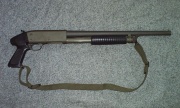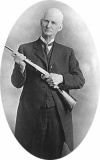Ithaca 37
| Ithaca Model 37 | |
|---|---|

| |
| Ithaca mod. 37 "Homeland Security" | |
|
| |
| Type | Shotgun |
| Land of Origin | United States |
| Specifications | |
| Length | Varies |
| Barrel length | (plain, ribbed, rifled) 13-30" (330-762mm) |
| Weight | 5.8 to 7.6 lbs unloaded |
| Gauge | 12, 16, 20, or 28 |
| Cartridge | 2 3/4" or 3" shotshells |
| Action | pump action |
|
| |
| Feed | 5 shot (4+1) tube with red safety follower and duck plug |
| Sights | fiber optic sights (current production) |
| Service History | |
| Wars | Vietnam War |
| Production History | |
| Designer | John Browning and John Pedersen |
| Design Date | 1933 |
| Manufacturer | Ithaca Gun Company |
| Produced | 1937-present |
| Variants | see Versions |
| 3 Briley choke tubes: full choke, modified (installed), and improved cylinder. | |
Contents[hide] |
[edit] History
Designed by the famous firearms designers John Browning and John Pedersen, the gun was initially marketed as the Remington Model 17. The Model 17 was a 20-gauge of trim proportions, later redesigned and refined into the popular Remington Model 31. That gun would eventually be replaced in production by the Remington 870 which is still produced to this day.
Following the First World War, the Ithaca Gun Company was searching for a pump-action shotgun to produce, primarily to compete with the Winchester Model 12. They settled on waiting for Remington Model 17 patents to expire. After gearing for production of the Ithaca Model 33, they discovered more Pedersen patents that would not expire until 1937; along with the introduction date, they changed the model designation from 33 to 37.
With the depression dragging on and war looming on the horizon, it was possibly the worst time to introduce a sporting arm. Many sporting arms ceased production entirely during the same period. While Ithaca did produce some shotguns for military use during the war, they also produced M1911 pistols and M3 Grease Guns.
After WW II, Ithaca resumed production of the Model 37. Made in many different models, the Ithaca 37 has the longest production run for a pump-action shotgun in history, surpassing that of the Winchester Model 12 that had originally inspired Ithaca to produce pump-action shotguns. Ithaca has suffered many setbacks in its history, changing hands numerous times. At one time, the Ithaca 37 was renamed the Model 87, although it was soon changed back in one of many ownership changes. Production paused in 2005 when Ithaca once again changed hands. Production has resumed in Ohio.
[edit] Users
The largest single user outside the US Military is the Los Angeles Police Department. Along with the Los Angeles County Sheriff's Department, numerous other users include military, police, security agencies, and prisons. The Ithaca 37 was a popular choice among civilians for both sport and personal protection. With higher prices for new Ithacas and decreasing availability compared to the Mossberg 500 and Remington 870, use of the Ithaca 37 continues to decline. Interestingly, Ithaca's loss of market share was hastened by competition from a copy of the shotgun. Chinese copies of the Ithaca 37 (itself a copy of the Remington Model 17) have been imported recently. Additionally, the supply of used civilian and departmental shotguns has been a steady competitor.
[edit] Operation
Loading the Ithaca 37 involves inserting shells of the proper gauge through the loading/ejection port and pushing them forward into the magazine until retained by the shell stop. The slide release is pressed and the slide retracted completely then pushed forward.
Pulling the trigger fires the gun and releases the slide for reloading. On most models, holding the trigger down causes the gun to fire the instant a new round is cycled into the chamber. Otherwise, the model 37 operates in much the same way as other pump-action shotguns.
[edit] Disassembly
Before attempting disassembly, unload the magazine and chamber (you wouldn't think we'd need to say that, but...). To empty the magazine, push in the spring shell stop (13) on the inside of the receiver. Ease the shells out one by one. Pull back on the slide release on the forward side of the trigger guard, and pull back the slide handle to empty the chamber.- To remove the barrel (1), pull back on the slide release and pull the slide handle assembly (12) to the rear to open the breech. Pull up the magazine nut pin (2) and use it as a lever to rotate the magazine nut (3) until the projection on it is free of the barrel lug. (The magazine nut pin was furnished only on guns built prior to 1955. On later-built guns having no pin, simply rotate the magazine nut.)
The barrel is joined to the receiver by an interrupted thread. When the magazine nut is free of the barrel lug, give the barrel a quarter turn to the left and pull it free of the receiver. The magazine tube and slide handle assembly will remain attached to the receiver. - The stock (53) must be removed before disassembling the action. First remove the buttplate screws and buttplate. The stock is attached to the receiver by a stock bolt (26) that has a square head with a slot so that it can be removed with a long screwdriver or socket wrench.
- With the stock removed, turn out the trigger plate screw (17) and slide the trigger plate group to the rear and out of the receiver. Remove the carrier screw lock screws (56) and carrier screws (55) from the receiver.
- Hold the receiver bottom up with the magazine to the left, and with a punch pull the slide pin (33) toward the body until the slide bar can be pulled forward from engagement with the slide (35). Pull the slide, breechblock (52) and carrier (42) together rearward out of the receiver.
- The top extractor (47) is retained by a powerful spring. To remove it, use a thin punch to push the spring plunger back; at the same time push the extractor out of its seat. The bottom extractor (43) can be removed easily by driving out its hinge pin (48). To remove the firing pin from the breechblock, first drive out the check pin (49). Then the firing pin and spring (51 and 50) can be removed easily rearward.
Reassembly is, naturally, in the reverse order.

[edit] Versions
There are versions too numerous to mention. Here are some popular models:
- Ultralite: an aluminum receiver variation.
- Deerslayer: a version with a shortened barrel and rifle-style sighting system.
- DSPS: for Deerslayer Police Special. A military and police version
- Stakeout: short version with 13 inches (330 mm) barrel and pistol grip stock
- 28 Gauge: 28 gauge model built on traditional size 28 gauge receiver.[1]
- Defense: an affordable 12 gauge model built for home defense purposes. 18.5" barrel with 5-round capacity or 20" barrel with 8-round capacity.
[edit] Featherlight
Model 37 Featherlight shotguns have been made in 20-, 16- and 12-ga. model variations including a 20-ga. Ultra Featherlight with an aluminum receiver, New Classic, Deluxe Vent Rib, English, Skeet, Trap, Sporting Clays, Turkeyslayer, Waterfowler and Youth models. Other model variations included the Deerslayer and Deerslayer II (the latter of which has a fixed/threaded barrel). Ithaca also produced shotguns for military use in the mid- to latter half of the 20th century. It built trench, riot and training Model 37s for the U.S. government. Also, riot models were available to civilians and police. Barrel lengths range from 20 inches for the riot gun, to 30 inches for the trap or duck guns.
[edit] Resources
| Gun Owners' Resource has the following relevant documents available for free download for the Ithaca 37 and/or its variants: |
- Ithaca 37 Owner's Manual - 5.4MB .pdf file
[edit] References
- Fawcett, Bill. Hunters & Shooters, An Oral History of the U.S. Navy SEALS in Vietnam. NY: Avon Books, 1995. ISBN 0-380-72166-X, pp. 79-80, especially.
- Snyder, Walter C. Ithaca Featherlight Repeaters, The Best Gun Going. NC: Cook and Uline Pub, 1998. ISBN 0-9629469-1-5
- Hoffschmidt, E. J., Ithaca Model 37 Featherlight Shotgun. American Rifleman, October 1960, Pg 35.
[edit] See also
Template:WWII US infantry weapons
| [show]This article is part of a series on the works of John Moses Browning |
|---|




